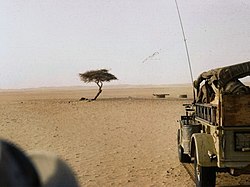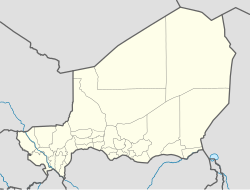Tree of Ténéré17°45′00″N 10°04′00″E / 17.75000°N 10.06667°E  Original location of the Ténéré Tree in Niger The Tree of Ténéré (French: L'Arbre du Ténéré) was a solitary acacia (Vachellia tortilis subsp. raddiana)[1][2][3] that was once considered the most isolated tree on Earth. It was a landmark on caravan routes through the Ténéré region of the Sahara Desert in northeast Niger, so well known that it and the Arbre Perdu (Lost Tree) to the north are the only trees to be shown on a map at a scale of 1:4,000,000. The tree is estimated to have existed for approximately 300 years until it was knocked down in 1973 by a drunk truck driver.[4] BackgroundThe Tree of Ténéré was the last of a group of trees that grew along the Azalai when the Sahara desert was less parched than it is today. The tree had stood alone for decades. During the winter of 1938–1939, a well was dug near the tree and it was found that the roots of the tree reached the water table 33–36 meters (108–118 feet) below the surface. Commander of the Allied Military Mission Michel Lesourd, of the Service central des affaires sahariennes [Central service of Saharan affairs], saw the tree on May 21, 1939:
The French ethnologist and explorer Henri Lhote described his two journeys to the Tree of Ténéré in his book L'épopée du Ténéré. His first visit was in 1934 on the occasion of the first automobile crossing between Djanet and Agadez. He describes the tree as "an Acacia with a degenerative trunk, sick or ill in aspect. Nevertheless, the tree has nice green leaves, and some yellow flowers". He visited it again 25 years later, on 26 November 1959 with the Berliet-Ténéré mission, but found that it had been badly damaged after a vehicle had collided with it:
   Death and monumentThe Tree of Ténéré was knocked down by a Libyan truck driver, reportedly drunk, in 1973.[6][7][4] On November 8, 1973, the dead tree was installed in a dedicated shrine on the grounds of the Niger National Museum in Niamey.[5] A simple metal sculpture representing the tree stands to mark its former location and general appearance in the desert.[7] Another replica - which better resembles the original tree - stands in the historic centre of Agadez (see image). In popular cultureThe sculpture representing the Tree of Ténéré and the Tree's story feature prominently in the 2006 film La Gran final (The Great Match). In the film, a group of Tuareg nomads in the Sahara race to find a power supply and broadcast reception for their television in time to watch the 2002 FIFA World Cup Final between Germany and Brazil, eventually using the tree sculpture as a makeshift antenna. In 2017, a group of artists created a massive, four-story tall LED sculpture entitled Tree of Tenere that was showcased at Burning Man. The sculpture consisted of 25,000 molded leaves containing 175,000 LEDs.[8] In 2021 the artists re-developed the sculpture and created a permanent installation in the Deep Ellum neighborhood of Dallas, Texas.[9] In 2018, the tree's story appeared as a main theme in the official music video of "Transmission/Michaelion"[10] by Ibeyi. See alsoReferences
External linksWikimedia Commons has media related to Arbre du Ténéré. |
Portal di Ensiklopedia Dunia














